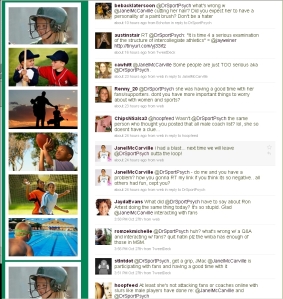Nearly one year ago at the urging a few tech saavy women around me, I decided to begin blogging. I wanted to, but needed a push. I desired to blog to create an outlet for sharing my thoughts and critical perspective on everyday things, hone my thinking and writing, and have a place to share with a wider audience some of the work I do that usually only shows up in academic journals. I felt I had a unique perspective about sports to share, and one not usually represented in many media outlets. I also wanted to answer Dave Zirin’s call he made in Contexts for academics, particularly sport sociologists, to “get off the bench.”
I am so glad for starting to blog for the following reasons, I have…
- met and connected with an entire network of creative, smart, and sports-minded women I would have never had the opportunity to meet if I didn’t start blogging (Thanks in part to Women Talk Sports Network!).
- sharpened how I make my arguments, including improving my ability to see and accept both sides of an issue.
- learned how to accept criticism of my work and my perspective, and not take it personally.
- learned that a critical perspective of sports is not a common one outside the ivory tower of academe.
- passed on what I have learned to my students and used my blogs as teachable moments in the classroom. This has helped connect abstract concepts to real life material, which I find enhances learning and increases student engagement.
- been invited to participate in blog panels and talk about my experiences in blogging.
- learned that everything I write is public, for better or worse…misspelled words, bad grammar, incorrect information and all!
- encouraged other women to make their voices heard in the blogosphere and claim what they know or think.
- thought about how easily I can be “found” on the WWW and how that is both good (i.e., brand recognition, marketing, relevancy) and bad (i.e., stalking, safety, can’t filter who reads or follows) for me personally and professionally.
- wondered who is reading my blog and the reasons behind what drives them to continue to visit.
- felt elated, proud, attacked, silenced, hesitant, skeptical, surprised, edified, and everything in between!
- (I hope) become a better writer, teacher, and researcher.
- thought about how digital media can both empower and further oppress marginalized groups who get so little attention in mainstream print and digital media.
- been honored and have enjoyed when blog readers send me stories they think I might turn into blog fodder or want to hear my “take” on a certain issue (keep sending me things!).
- wondered if I will run out of things to say.
…and most of all I have felt compelled to continue to blog. Thank you for reading this blog–One Sport Voice. I hope you will visit often, comment when you feel moved to do so, and encourage others to do the same.

















